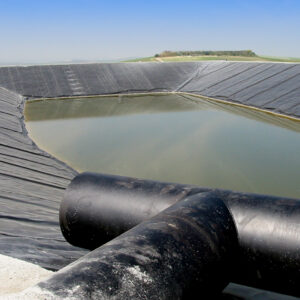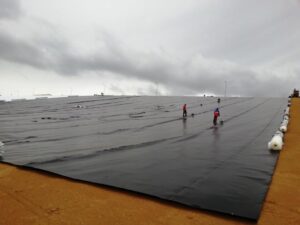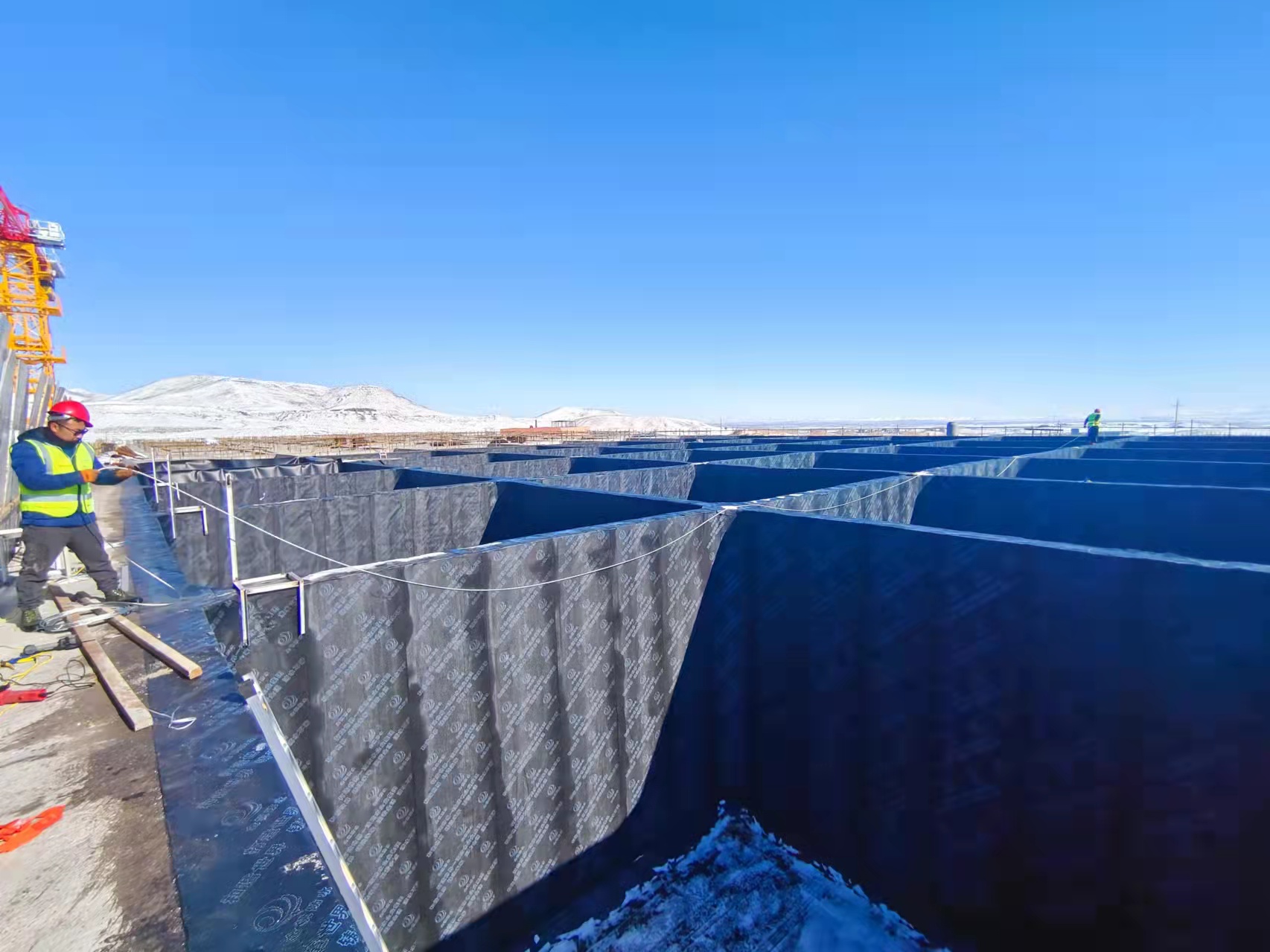What types of geomembranes are there?
Geomembranes are synthetic materials used in civil and environmental engineering applications for containment and barrier systems. They are designed to control the movement of fluids, prevent leaks, and protect against environmental hazards. Various types of geomembranes are available, each with specific properties suited to different applications. The common types of geomembranes include:
High-Density Polyethylene (HDPE):
Properties: Excellent chemical resistance, high tensile strength, and durability. UV resistant.
Applications: Landfills, mining heap leach pads, pond liners, waste containment.
Linear Low-Density Polyethylene (LLDPE):
Properties: Flexible, good puncture resistance, and chemical resistance.
Applications: Landfills, pond liners, secondary containment.
Low-Density Polyethylene (LDPE):
Properties: Flexible, relatively low tensile strength.
Applications: Agricultural pond liners, canal liners, landscaping.
Polyvinyl Chloride (PVC):
Properties: Chemical resistance, flexibility, and weldability.
Applications: Landfills, wastewater treatment, pond liners.
Ethylene Propylene Diene Monomer (EPDM):
Properties: Flexible, good resistance to weathering and UV.
Applications: Pond liners, decorative water features, landscaping.
Polypropylene (PP):
Properties: Good chemical resistance, lightweight, and flexible.
Applications: Secondary containment, landfill caps, reservoirs.
Chlorosulfonated Polyethylene (CSPE or Hypalon):
Properties: Excellent chemical resistance, UV resistance, and durability.
Applications: Landfills, wastewater treatment, chemical containment.
Thermoplastic Polyolefin (TPO):
Properties: Good chemical resistance, flexibility, and weldability.
Applications: Landfills, water containment, roofing membranes.
Polyethylene Terephthalate (PET):
Properties: High tensile strength, puncture resistance.
Applications: Reservoir liners, canal liners, waste containment.
Bituminous Geomembranes:
Properties: Composed of bitumen and reinforced with polymers.
Applications: Landfills, reservoirs, tunnel liners.
The choice of geomembrane type depends on the specific requirements of the project, including the type of containment, environmental conditions, chemical exposure, and other factors. Each type of geomembrane has its advantages and limitations, and proper selection is crucial for the success and longevity of the containment system.

How to extend the life of geomembrane?
Extending the life of geomembrane liners involves careful consideration of installation practices, maintenance, and monitoring. Here are some tips to help maximize the service life of geomembranes:
Proper Installation:
Ensure that the geomembrane is installed by trained and experienced personnel.
Follow manufacturer guidelines and specifications for installation procedures.
Minimize wrinkles, folds, and stress points during installation to reduce the risk of damage.
Surface Preparation:
Adequately prepare the subgrade and remove any sharp objects or debris that could puncture or damage the geomembrane.
Use a protective layer, such as geotextile fabric, to cushion and protect the geomembrane from potential damage.
Quality Control:
Implement quality control measures during installation to identify and correct any issues promptly.
Conduct seam testing to ensure the integrity of welded or bonded seams.
Monitoring and Inspections:
Regularly inspect the geomembrane for signs of damage, including punctures, tears, or stress points.
Implement a monitoring program to detect and address any issues before they escalate.
Avoidance of Chemical Exposure:
Select a geomembrane material that is suitable for the specific chemical environment it will be exposed to.
Minimize exposure to chemicals that could degrade the geomembrane material.
UV Protection:
Utilize geomembranes with added UV stabilizers or install additional protection, such as shading, to minimize UV exposure.
Proper Sloping and Drainage:
Ensure proper slope and drainage design to prevent the accumulation of water or other fluids on the geomembrane surface, which could lead to increased stress.
Temperature Considerations:
Be aware of temperature extremes and select a geomembrane material that is suitable for the anticipated temperature range.
Repair and Maintenance:
Address any identified issues promptly through proper repair techniques.
Regularly maintain and clean the geomembrane surface to prevent the accumulation of debris or contaminants.
Record Keeping:
Maintain detailed records of installation, inspections, repairs, and maintenance activities.
Keep records of the geomembrane material specifications and manufacturer recommendations.
By implementing these practices, site operators and engineers can enhance the longevity and performance of geomembranes in various applications. Regular monitoring and proactive maintenance are key components of a successful geomembrane management strategy.

What is the service life of geomembrane?
The service life of a geomembrane can vary depending on several factors, including the type of geomembrane material, environmental conditions, installation quality, and intended use. Geomembranes are synthetic liners used in various civil and environmental engineering applications to control the movement of fluids, such as in landfill liners, mining heap leach pads, pond liners, and other containment systems.
Here are some general guidelines for the service life of common geomembrane materials:
High-Density Polyethylene (HDPE): HDPE geomembranes are known for their durability and resistance to chemicals. They typically have a service life ranging from 20 to 30 years, but this can be influenced by factors such as UV exposure, temperature variations, and chemical exposure.
Linear Low-Density Polyethylene (LLDPE): LLDPE geomembranes are flexible and have good puncture resistance. Their service life is often in the range of 20 to 25 years.
Polyvinyl Chloride (PVC): PVC geomembranes are known for their chemical resistance. They typically have a service life of 20 years or more, depending on the specific formulation and environmental conditions.
Ethylene Propylene Diene Monomer (EPDM): EPDM geomembranes are commonly used in applications such as pond liners. They can have a service life of 20 to 30 years or more, depending on exposure conditions.
Polypropylene (PP): PP geomembranes are used in specific applications where chemical resistance is essential. Their service life is generally in the range of 15 to 20 years.
It’s important to note that these estimates are general guidelines, and actual service life can be influenced by site-specific conditions, installation practices, and the specific formulation of the geomembrane. Regular inspections and maintenance can help extend the life of geomembrane liners. Additionally, advancements in geomembrane technology may result in new materials with longer service lives in the future.
Author

Founded in 2002, Tinhy's team focuses on the manufacturing, marketing, installation, application and research and development of geosynthetic materials.
View all posts





